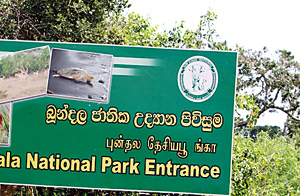Free Hold
Department of Wildlife Conservation join hands with LOLC Group
View(s):to eradicate invasive “Kalapu Andara” from Bundala National Park
According to high priority environmental conservation, a renewable energy production firm, United Dendro Energy Private Limited, a subsidiary of LOLC steps into conserve the ecological heritage of Bundala National Park, a renowned bird sanctuary and beautiful wet land, located close to the City of Hambantota in the Southern Province of Sri Lanka, officials said.

Kithsiri Gunawardena
The company has recently launched a special ecological conservation project to systematically remove the two species of invasive plants, “Kalapu Andara” Prosopis juliflora and “Pathok” OpuntiaDilainii which has already invaded the Bundala National Park, narrowing the existing grazing lands for wild animals and habitats of the migrant and resident wading birds as well as other species, they revealed. Bundala National park which is the first ever park in the country to be declared as a Ramsar site, is one of the most important feeding grounds for hundreds of thousands of migrant birds that spend the winter months of the year in the country.
The salinity level of the water in the lagoons had changed by the draining of excess fresh water from irrigation systems, which had posed a threat to the park’s bio diversity, and measures are now being considered to remedy this situation as well. Mr. H.D Ratnayake, Director General of the Department of Wildlife Conservation (DWC) mentioned at the launch of this project on the 3rd February 2013.
Mr. Kithsiri Gunawardena, Chief Operating Officer LOLC and Chief Legal Officer LOLC Group said that the company has entered in to an agreement with the Department of Wild Life Conservation and undertaken the task of removing both these invasive species using specially imported machines such as “brush cutters” and “Grapples” to ensure minimum damage to the soil. The woody parts of the “Kalapu Andara” would be removed from the park and chipped using a “chipping machine” that has been imported from Japan.
These chips will be used as fuel to power the Dendro Power Plants of the company and the electricity generated will the supplied to the national grid on a commercial basis. Cactus, the other invasive plant that would be removed has no commercial value but would also be removed to ensure the enrichment of the habitat of the park.
This is a sustainable project that has created the right incentive for a privet sector company to engage in the removal of these invasive species which is choking the life out of the native plant species from Bundala National Park. The scale of this project in fact has the capacity to retard the spreading of these invasive plants in the National park. The company is totally committed and has already invested about 100 million rupees for machinery alone to make this project a success.

Under the project, the DWC has identified a total land area of 454 hectares to be systematically cleared over a period of five years to ensure minimum disturbance to the wild animals in the park.
This project will be implemented in collaboration and under the direct supervision of the DWC, he disclosed.
It is in full compliance with the Flora & Fauna Protection Ordinance. The required environmental assessments regarding the project has already been conducted and based on its recommendations, the invasive plant species are being extirpated, the Wildlife Department said.
It was only in 1991 that the Bundala National park was incorporated into the global list of Ramsar wet lands. It is the first Sri Lankan wet land to be incorporated into the global Ramsar wet land list.
Brackish water, salt pans, mangroves, lagoons, lakes and salterns are some of the key land features visible within the park.
A large number of migratory bird species are known to frequent the Bundala National Park during winter in the Northern Hemisphere, which in turn draws a large number of foreign and local tourists to the park annually.
1/3 of the national park is covered in water sources, while the park itself holds great historical and archaeological significance. As with all wet lands, advancements in development have had a negative impact on the water quality of the Bundala National Park.
To coincide with this project, Sri Lanka’s first ever wet land laboratory was opened in the Bundala National Park by Senior Advisor of the Ramsar Convention’s Asia-Oceania Region, Professor Lee Ying and the Director General Department of Wildlife ConservationMr. H.D. Ratnayake. Dr. Ying commended the United Dendro Energy for undertaking such a project that would help enrich and restore the habitat of the Bundala National Park.
The need for a wet land laboratory arose and the equipment needed was provided by UNESCO on a request made by the Department of Wildlife Conservation.
The laboratory would carry out tests to ascertain the quality of wet land water samples, maintaining data banks and data collection of its visiting bird species, a press release issued by DWC said.
Furthermore, the laboratory would even be entrusted with ascertaining the water quality of non-domestic wet lands as well, it added.
At the Press Conference held in Bundala on the 3rd February, Dr. Lee Ying emphasized that the Private and Public partnership to eradicate this threat was an excellent initiative. Further he stated that this was the solution that was needed at this juncture.
United Dendro has already entered into a power purchase agreement with the Ceylon Electricity Board (CEB) to supply 10 megawatts of electricity to the national grid and it will sell a kilo watt of power at the rate of Rs. 20 which is expected be increased eventually to Rs.25.09.
The company has invested approximately Rs. 100 million for this project so far and a 10MW power plant which is being built in the Hambantota District will cost the company US $ 16 million.
Mr. Gunewardena pointed out that even though the company had the option of purchasing fuel wood from third parties they decided against this method considering the harmful impact it may have on even the protected forests of the country. Thus, the company has identified only three sources in order to obtain fuel wood for the power plants which will not have even an indirect impact on our protected forests.
They are to have wood chips from its own plantation of Gliricedia, wood chips from the invasive “Kalapu Andara” and purchasing Gliricediasticks from third parties such as farmers. We have did not consider the option of purchasing fuel wood from small time farmers as they may cut trees from protected forest reserves due to the demand that would be created. The primary fuel wood to be used for the Dendro Power project would be the wood chips from “Kalapu Andara” and ‘Gliricedia which is commonly found throughout the country.
Without purchasing the fuel wood for the dendro power plants from suppliers, which can lead to the felling of even the protected forest by many small time fuel wood providers, the company decided to have its own plantation even though it is an expensive option.
Follow @timesonlinelk
comments powered by Disqus


















